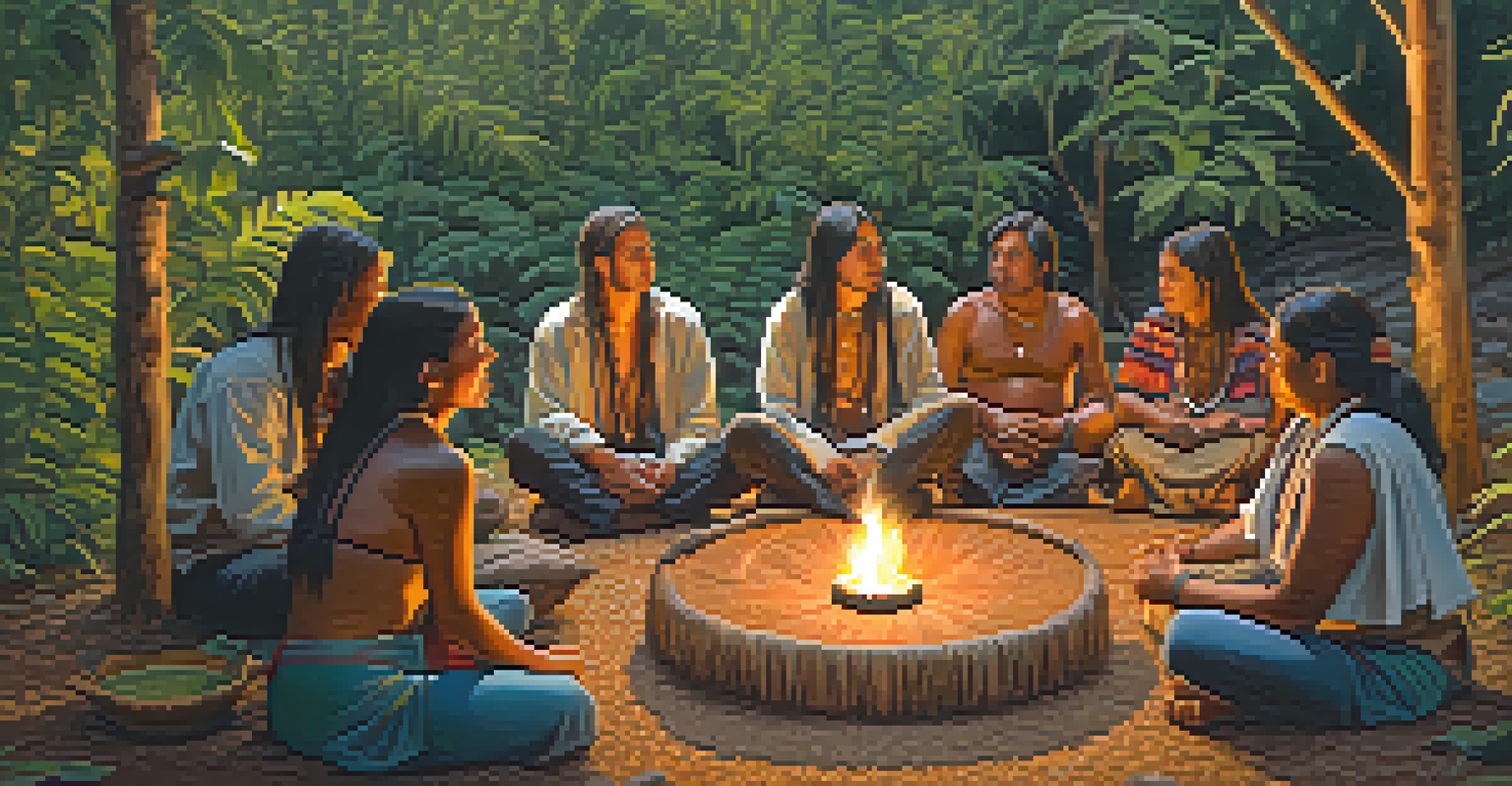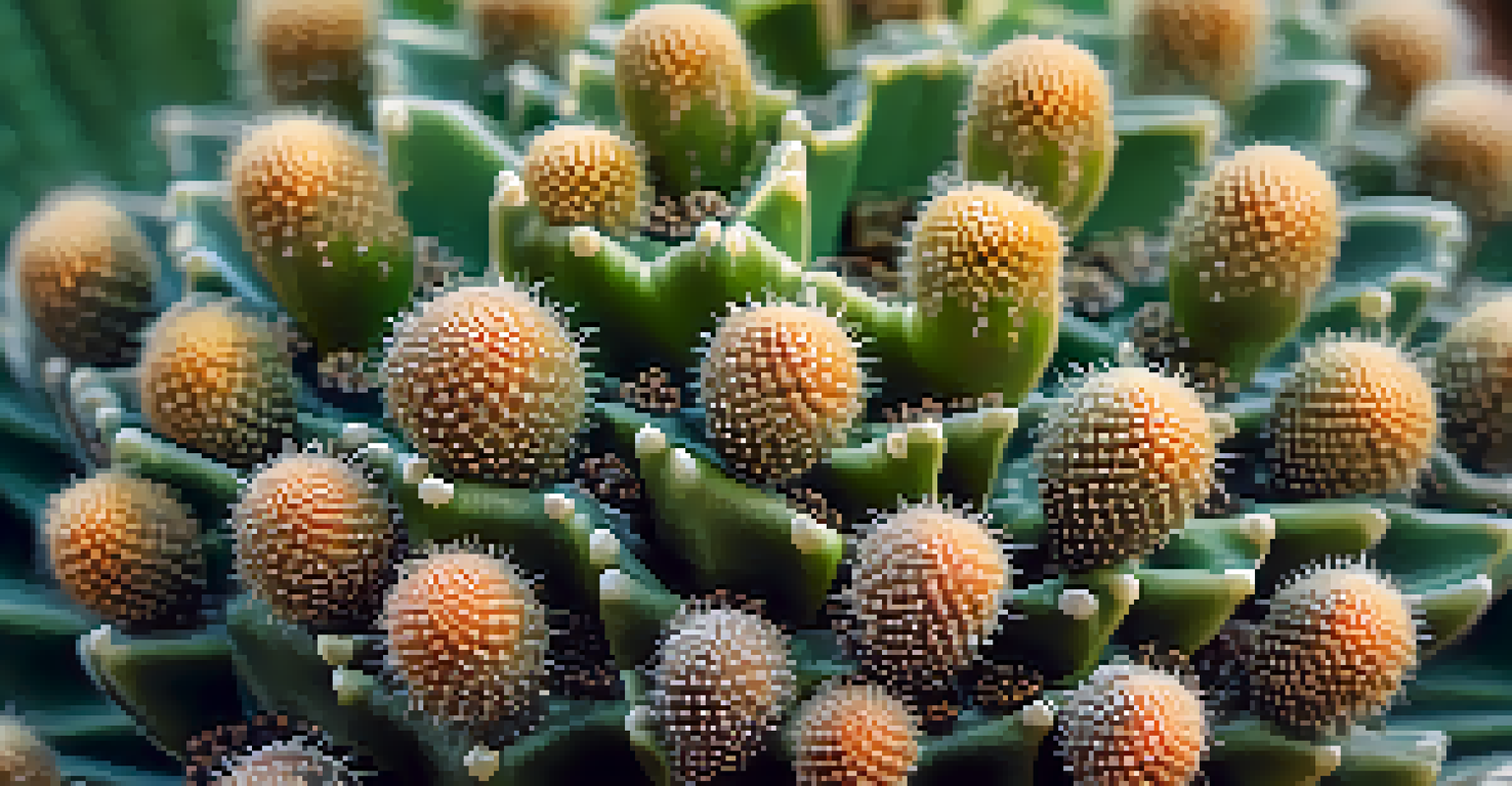The Historical Roots of Peyote in Indigenous Cultures

Understanding Peyote: A Brief Overview
Peyote is a small, spineless cactus native to the southwestern United States and Mexico, known for its psychoactive properties. Traditionally, it contains the alkaloid mescaline, which has been used for centuries by Indigenous peoples in spiritual and healing practices. The cactus has become a symbol of cultural identity and resilience among various tribes, particularly the Huichol and Navajo.
The use of peyote is a deeply spiritual experience that connects us to our ancestors and the universe.
As a hallucinogen, peyote induces altered states of consciousness, allowing users to connect with spiritual realms. This connection is often seen as a way to gain insight, heal emotional wounds, or commune with the divine. The use of peyote in rituals is not merely recreational; it is deeply embedded in the cultural fabric of Indigenous communities.
Overall, understanding peyote involves recognizing its complexity as both a physical plant and a spiritual tool. For many, it represents a bridge between the material world and spiritual existence, making it much more than just a substance to be consumed.
Peyote's Role in Indigenous Spiritual Practices
In many Indigenous cultures, peyote is integral to religious ceremonies and rituals. These practices often involve group settings where participants share their experiences and insights gained during peyote use. The communal aspect enhances the spiritual journey, fostering deeper connections among participants and with their ancestors.

For tribes like the Huichol, peyote is a sacred gift from the gods, symbolizing life, death, and rebirth. Ceremonies often last for days, encompassing prayers, songs, and storytelling, all of which are essential to the healing and transformative process. Such gatherings not only serve spiritual purposes but also strengthen community bonds.
Peyote's Cultural Significance
Peyote serves as a vital symbol of cultural identity and spiritual connection for Indigenous communities.
Moreover, peyote is viewed as a teacher, guiding individuals through their personal and collective struggles. Many participants report profound experiences that lead to realizations about life, purpose, and identity, further solidifying its importance in their spiritual practices.
Historical Context: Peyote Use Through the Ages
The use of peyote dates back thousands of years, with archaeological evidence suggesting its consumption in Mesoamerica as early as 5,500 BCE. Indigenous peoples have long recognized its psychoactive properties and incorporated peyote into their cultural practices. The historical significance of peyote showcases the deep-rooted connection between these communities and their environment.
Peyote is a teacher, guiding us through our personal struggles and connecting us to a greater purpose.
Spanish colonization in the 16th century brought about significant changes, as European settlers attempted to suppress Indigenous practices, including the use of peyote. Despite these challenges, many tribes maintained their traditions, adapting and preserving their cultural heritage in the face of adversity. This resilience is a testament to the enduring importance of peyote in their lives.
In the late 19th and early 20th centuries, peyote use gained further recognition as the Native American Church emerged, blending traditional practices with Christian elements. This movement allowed for a more structured approach to peyote ceremonies, providing a space for Indigenous peoples to reclaim their cultural identity and spirituality.
Cultural Significance of Peyote in Modern Society
Today, peyote remains a focal point of cultural identity for many Indigenous groups. Its significance extends beyond ceremonial use, influencing art, music, and literature that reflect the experiences and stories of these communities. Modern artists often integrate peyote symbolism into their work, celebrating their heritage and promoting cultural awareness.
Moreover, the legal landscape surrounding peyote use has evolved, especially with the establishment of the American Indian Religious Freedom Act in 1978. This act acknowledges the right of Indigenous peoples to practice their religious beliefs, including the use of peyote. However, legal challenges still persist, reflecting ongoing struggles for cultural recognition.
Challenges to Peyote Sustainability
Indigenous groups face issues like overharvesting and legal obstacles that threaten the sustainability of peyote.
As society becomes more aware of Indigenous rights and traditions, peyote serves as a powerful symbol of resilience and cultural survival. It prompts discussions about the importance of preserving Indigenous knowledge and practices in an increasingly globalized world.
Challenges Faced by Indigenous Communities Regarding Peyote
Despite its cultural significance, Indigenous communities face numerous challenges surrounding peyote use. One major issue is the overharvesting of peyote, which threatens its natural populations. As demand increases, many tribes are concerned about the sustainability of this sacred plant and the future of their ceremonial practices.
Additionally, there are ongoing legal battles regarding the rights of Indigenous peoples to use peyote. While some protections exist, they are often insufficient, and the complexities of federal and state laws can create barriers for those wishing to engage in traditional practices. This legal uncertainty can lead to feelings of vulnerability among Indigenous communities.
These challenges highlight the need for greater awareness and respect for Indigenous rights and traditions. By advocating for sustainable practices and legal protections, society can help ensure the preservation of peyote and its cultural significance for future generations.
The Future of Peyote in Indigenous Cultures
Looking ahead, the future of peyote in Indigenous cultures will depend on various factors, including environmental conservation and legal recognition. Efforts to cultivate peyote sustainably are crucial to protect its populations and ensure that future generations can participate in traditional ceremonies. Community initiatives aimed at reforestation and cultivation can play a significant role in this endeavor.
Moreover, education and awareness about the cultural significance of peyote can empower Indigenous communities and foster respect among non-Indigenous populations. By sharing stories and experiences, tribes can help break down stereotypes and promote understanding of their traditions. This cultural exchange can lead to stronger alliances and support for Indigenous rights.
Future of Peyote in Indigenous Cultures
The future of peyote depends on environmental conservation efforts and the legal recognition of Indigenous rights.
Ultimately, the future of peyote is intertwined with the resilience of Indigenous cultures. As these communities continue to adapt and thrive, peyote will remain a cherished symbol of their identity, spirituality, and connection to the land.
Conclusion: Celebrating Peyote's Legacy
In conclusion, peyote is much more than a substance; it embodies the rich history and enduring traditions of Indigenous cultures. Its role in spiritual practices, community gatherings, and artistic expressions highlights the deep connection between these communities and the natural world. Understanding peyote's significance encourages us to appreciate the wisdom and resilience of Indigenous peoples.
As we celebrate the legacy of peyote, it's essential to acknowledge the ongoing challenges faced by Indigenous communities. By supporting their rights and advocating for sustainable practices, we can contribute to the preservation of their cultural heritage and ensure that future generations can continue to engage with this sacred plant.

Ultimately, peyote serves as a reminder of the importance of honoring diverse cultures and the wisdom they hold. By fostering respect and understanding, we can create a more inclusive society that values the rich tapestry of human experience.